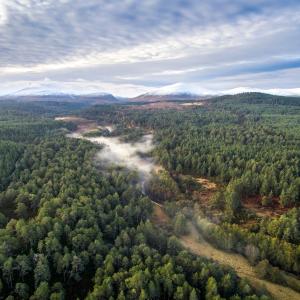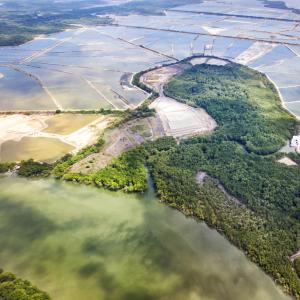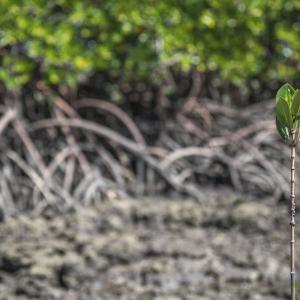After almost two years of support, in early 2025, representatives from projects participating in the Nature-based Solutions (NbS) Accelerator gathered in London.
The Accelerator projects reflected on progress towards their goal of designing high-quality NbS projects using global standards and reaching investment readiness. Together they shared some key insights.
Designing NBS
Laying the groundwork for investment readiness early on is vital
Project representatives highlighted the importance of integrating economic thinking early in the NbS design process. While economic viability is a core criterion for all NbS project (IUCN Global Standard), this insight focuses on projects striving to attract private or blended finance. Not all NbS projects are suited for private financing but, for those that identify an opportunity to do so, participants shared that practitioners should begin by laying the foundations of a strong business case early. This includes identifying potential revenue streams, market access issues, and prospective buyers or intermediaries. These elements can be refined through stakeholder engagement, monitoring, and piloting, ensuring the final investment case is both robust and contextually grounded.
A place-based approach is key to mapping and managing risk
Practitioners should adopt a place-based approach during the scoping phase to identify and address potential region-specific challenges, such as legal restrictions and regulatory requirements. This approach will also help build local relationships and contextual understanding. This proactive strategy can prevent costly delays and improve project feasibility.
Peer learning and demonstration sites are crucial to build trust and accelerate adoption
For NbS in agriculture, field schools and pilot farms play a vital role in fostering peer-to-peer learning, building trust, and strengthening capacity. These demonstration sites help practitioners and communities see tangible benefits – such as increased production or reduced deforestation – which are essential to encourage uptake. The Accelerator experience showed that showcasing proof of concept in real-world settings can significantly accelerate the adoption of regenerative agricultural practices.
Early stakeholder engagement and inclusive co-design help to establish a “trust chain”
Trust is essential across the entire value chain, from local communities to investors. Establishing a “trust chain” early – by listening to diverse stakeholder needs and expectations and addressing them well before contracts are signed – can reduce friction in risk assessments and negotiations and helps set the foundation for positive collaboration during project implementation. This requires a lot of time, transparency, and consistent engagement.
Some projects underestimate the time required to build landscape-level partnerships. Early engagement with commercial, governmental, and community actors is essential to align interests, accelerate implementation and reduce the risk of conflict. Projects that prioritise co-design and local ownership tend to enjoy greater legitimacy, uptake, and long-term success.
Monitoring and Evaluation frameworks, in particular, should be co-developed with local stakeholders while also considering investor needs – ensuring accountability, responsiveness to local needs, and adaptability.
Financing NBS
Non-return seeking finance options (e.g. grants) are crucial as seed capital for early stage NbS design and implementation
The initial phase of NbS design and piloting requires significant upfront capital for staff time, scoping, feasibility studies, partnership building, piloting, and community engagement – phases that are essential to creating high-integrity projects that are economically viable in the long-term. However, funding at this stage is often limited. Using a mix of funding sources, such as philanthropic grants, to fund the early stages of an NbS, then seeking commercial investors later, can be essential to bridge this gap and lay the groundwork for scalable solutions.
NbS success stories are needed to tackle unfavourable investor perceptions
NbS are often seen by investors as higher risk due to a lack of familiarity, perceived complexity, and long timeframes. This can hinder capital-raising efforts. To build investor confidence, there is a strong demand for case studies that not only demonstrate technical integrity but also provide proof of concept for successful financing – showing both the projects, and financial structures are viable.
Investment structures and exit strategies should be clearly communicated to investors
Investors often face uncertainty about what they are purchasing and how they can exit the investment. Clear, well-articulated business plans, financing structures and exit strategies are essential to building investor confidence and facilitating meaningful dialogue.
While diverse revenue streams can enhance financial resilience, too many revenue sources – or overly complex operational models to manage them – can increase risk and deter investors. This is especially true when projects rely primarily on novel mechanisms.
These insights reinforce the value of engaging prospective investors early to test appetite for proposed models, and the importance of clarity and simplicity in financial structures – balancing creative innovation with investor expectations. Where fewer revenue streams may offer more certainty but lower returns, concessional capital may be more appropriate initially, with additional revenues layered over time to support a transition towards commercial capital.
Aligning with values-driven investors improves credibility
Projects gained credibility and market access when backed by investors whose values aligned with those of the community. This alignment was especially important in premium markets, where trust and legitimacy are critical to adoption and long-term success.
The need to establish financial benchmarks for the NbS sector
There is a growing need for standardised financial benchmarks for different types of NbS. Understanding cost per hectare, transaction precedents, and revenue expectations can help position NbS as a credible competitor in asset classes like agriculture and infrastructure. Tools and templates to support this benchmarking process are also in demand. This would allow investors to more easily assess different opportunities – understanding how costs and returns compare to other equivalent projects – and would help practitioners speed the process of building a cost and financial model.
*The Climate Solutions Partnership is a five-year philanthropic partnership between HSBC, the WRI, and WWF to scale climate solutions.






